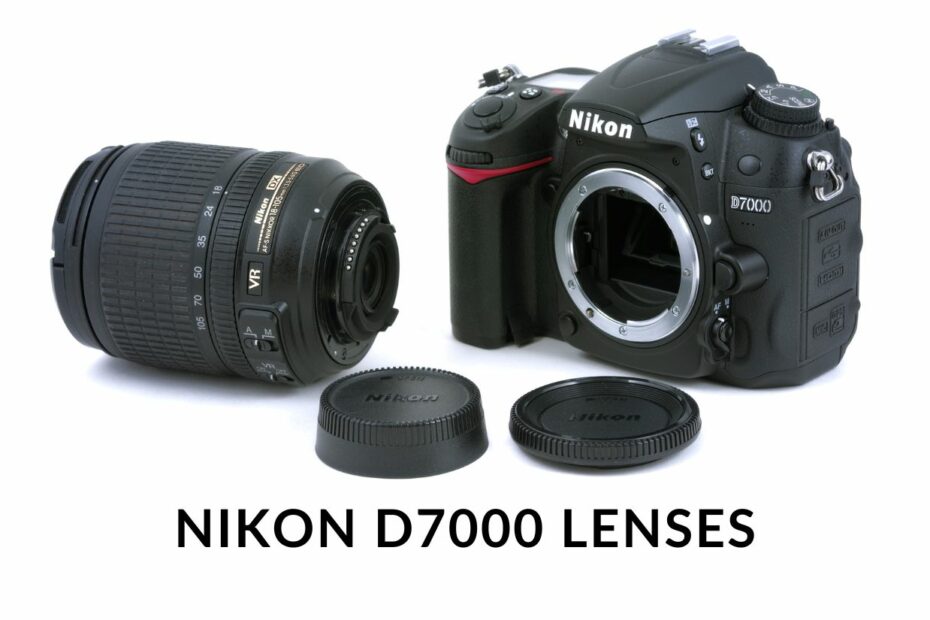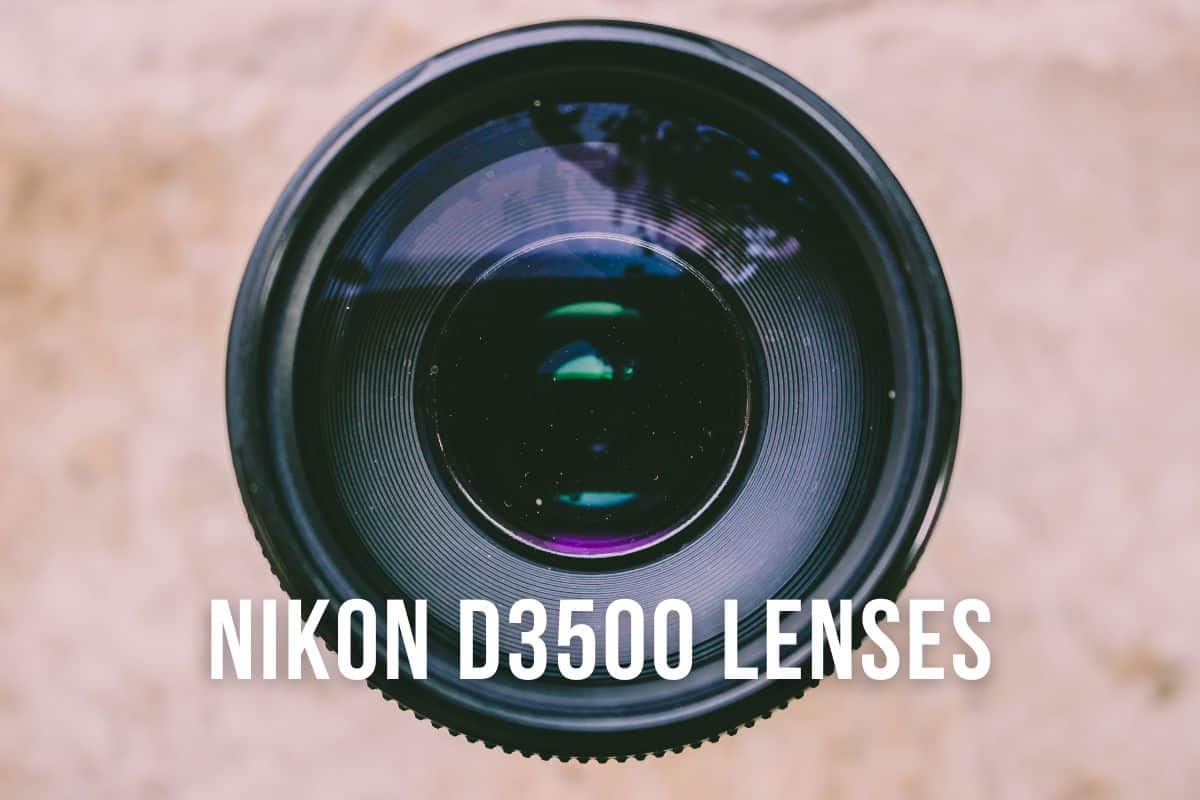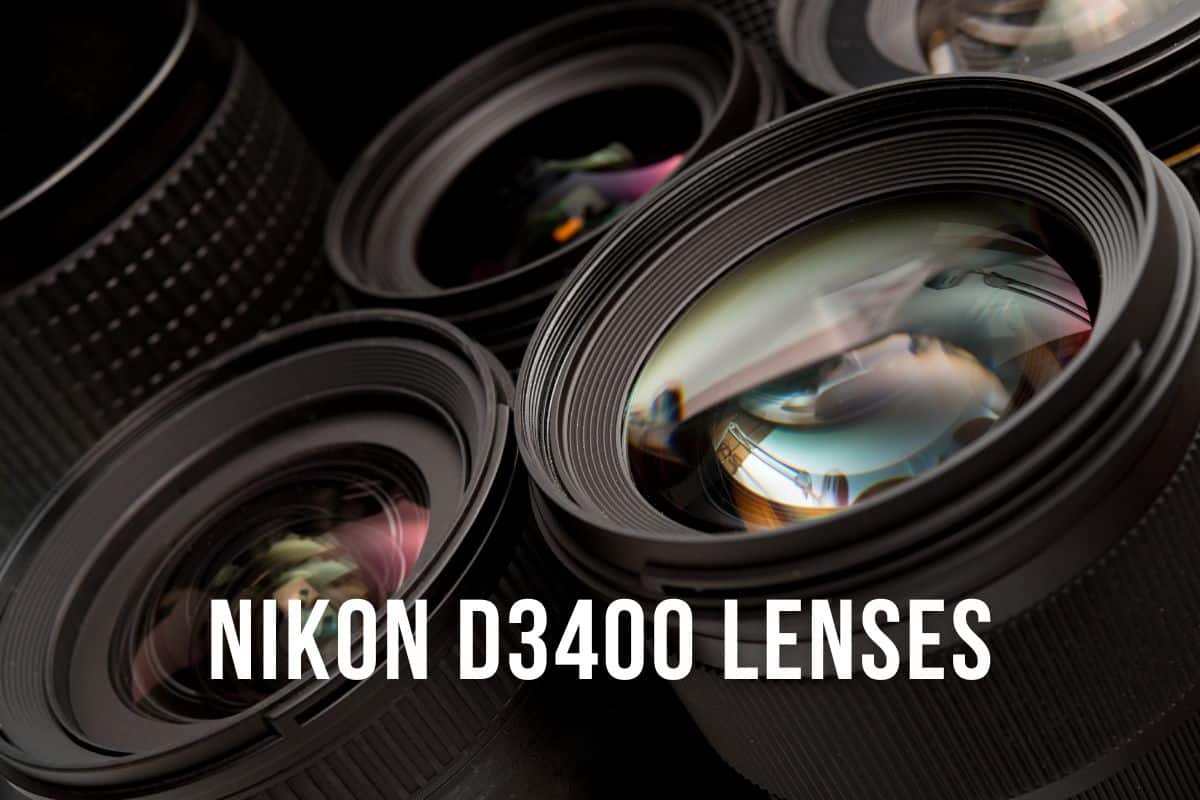The Nikon D7000 is mainly favored by amateur and hobbyist photographers, whether just starting out or simply pursuing photography as a pastime. The camera’s versatility and the range of lenses available for various photography styles, such as portrait, telephoto, wide-angle, zoom, and prime, make it a highly sought-after option.
In this list, we’ve gathered the best lenses for Nikon D7000 users, focusing on affordable options, particularly for those just starting. Nevertheless, we’ve also included a few high-end, professional-quality lenses for those who want to take their photography skills to the next level.
Read more: How to Choose a Camera Lens That Fits Your Needs.
Disclosure: This article features affiliate links, including Amazon.com. If you decide to buy through one of these links, I’ll earn a small commission at no extra expense to you. For more details, please see my disclosure policy.
We have provided brief details on a collection of lenses, including their cost ranges, specifications, performance, and ideal usage scenarios. The lenses have been classified according to their type, and the cost range is indicated as follows:
- 0 – 500$ – Budget $
- 501 – 900$ – Average $$
- 901+ $ – Expert $$$
The list of Nikon D7000 lenses:
PORTRAIT lenses
1. Nikon AF-S Nikkor 85mm f/1.8G
2. Nikon AF-S Nikkor 50mm f/1.8G
3. Sigma 30mm f/1.4 ART DC HSM Lens
ZOOM lenses
4. Sigma 18-35mm F1.8 Art DC HSM
5. Sigma 17-50mm f/2.8 EX DC OS HSM
6. Sigma 17-70mm F2.8-4 Contemporary DC Macro OS HSM
WIDE-ANGLE lenses
7. Tokina AT-X PRO 11-16mm F2.8 DXII Lens
TELEPHOTO lenses
8. Sigma 150-600mm 5-6.3 Contemporary DG OS HSM
9. Nikon AF-P DX NIKKOR 70-300mm f/4.5-6.3G ED
MACRO lens
10. Nikon AF-S VR Micro-NIKKOR 105mm f/2.8G IF-ED
Portrait lenses
1. Nikon AF S Nikkor 85mm f/1.8G
- Price: Budget $
- Dimensions: 3.1 x 2.9 in / 80 x 73 mm
- Weight: 12.4 oz / 350 g
- Filter size: Ø67
- Maximum aperture: f/1.8
- Focal length: 85 mm
- Image stabilization: No
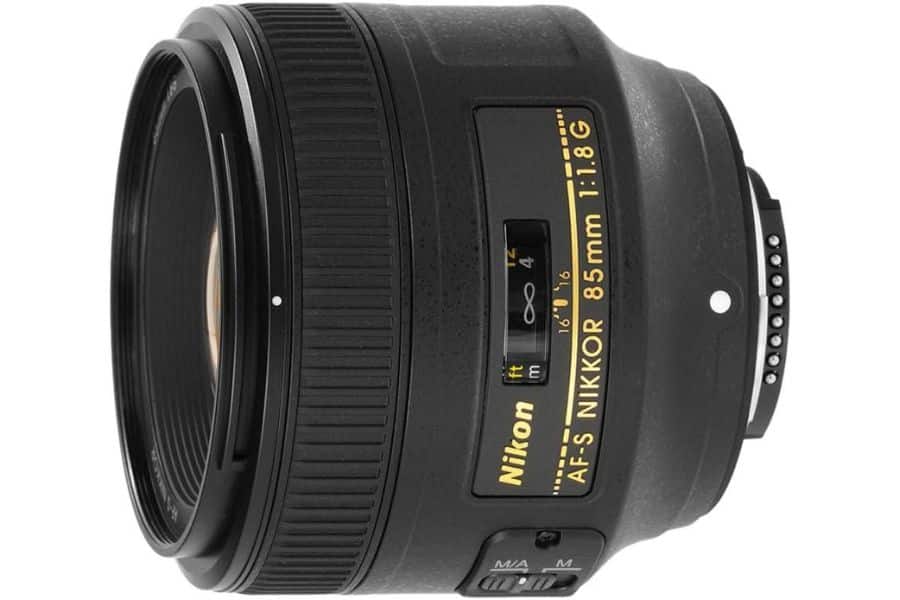
PROS:
+ Soft bokeh effect
+ Focal length of 85mm
+ Quick focusing
CONS:
– No built-in image stabilization
The debate surrounding the best lens for portraits is ongoing, as no definite answer exists. The most frequently discussed lenses for this purpose are 35mm, 50mm, and 85mm prime lenses.
Build and handling: The Nikon 85mm f/1.8G, like other recent Nikon prime lenses, has a robust design with a plastic exterior and a metal lens mount. It also includes a rubber seal on the mount that effectively blocks out dust. Despite its seemingly large size, this lens is surprisingly lightweight.
Performance: The portrait lens’s wide f/1.8 aperture makes it an excellent option for low-light photography and produces a shallow depth of field that separates subjects from the background. It offers two focusing modes, manual priority AF and manual focus, and is equipped with a fast and silent wave motor, making it ideal for videography.
Best for: As previously noted, this one here is well-suited for portrait photography, but with a talented photographer behind the lens, it can be utilized for various photography styles such as product, event, and wedding photography, where it is expected to deliver outstanding results.
It creates a creamy background, shallow depth of field, and sharp contrast. If you want to enhance your portrait work, this lens is an excellent option, delivering remarkable results at a reasonable cost.
2. Nikon AF-S Nikkor 50mm f/1.8G
- Price: Budget $
- Dimensions: 2.8 x 2.1 in / 72 x 52.5 mm
- Weight: 6.6 oz / 185 g
- Filter size: Ø58
- Maximum aperture: f/1.8
- Focal length: 50 mm
- Image stabilization: No
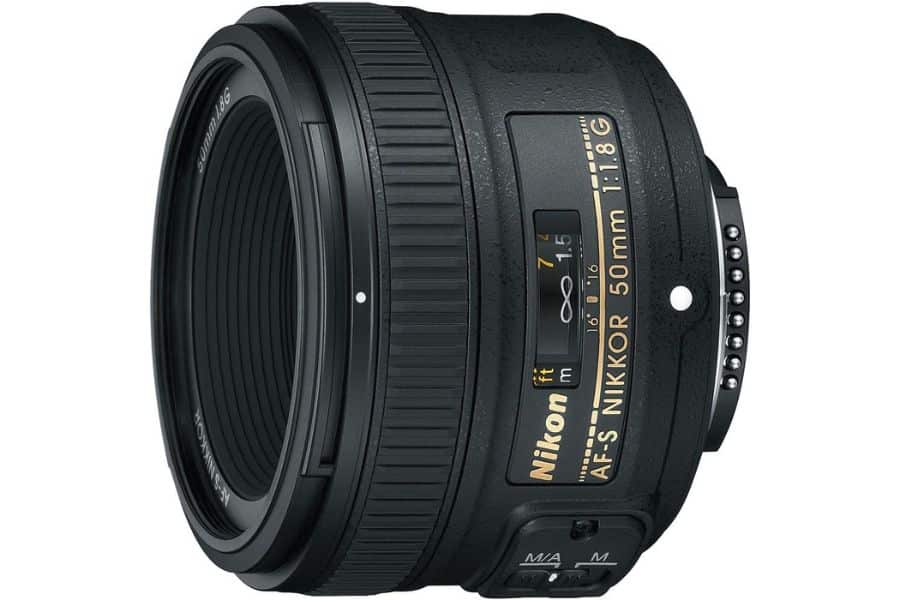
PROS:
+ Lightweight
+ Extremely affordable
+ Fast autofocusing
CONS:
– A bit of visual distortion
A lens designed for beginner photographers offers multiple benefits and has comparable specifications to an earlier Nikon lens. It is an economical choice that is a smart addition to your camera kit if you want to save money initially.
Build and handling: Like its predecessor, this lens is also intended for consumer use and comes with all the necessary buttons and information. Compared to the previous option, this portrait lens is even lighter, weighing only 6.6 oz (185 g), making it an excellent choice for extended hand-held photography sessions.
Performance: It boasts an aperture of f/1.8, producing beautiful bokeh, clear subject differentiation from the background, and outstanding results in low-light conditions. The autofocus speed of this lens may be average, but its overall image quality is remarkable. The only drawback is a lack of sharpness in the corners and edges when using wide apertures.
Best for: As anticipated, this lens is primarily designed for portrait photography, but compared to its predecessor, it requires less room to frame your subjects. It can also be used for indoor photography, although not in extremely confined spaces. Furthermore, it can capture product details, landscapes, events, and wedding photography.
With its large aperture, lightweight build, and remarkable image quality, this lens provides numerous advantages at an affordable price, making it an excellent choice for beginners to explore portrait photography.
3. Sigma 30mm f/1.4 ART DC HSM Lens
- Price: Budget $
- Dimensions: 2.9 × 2.5 in / 74.2 × 63.3 mm
- Weight: 15.3 oz / 435 g
- Filter size: Ø62
- Maximum aperture: f/1.4
- Focal length: 30 mm
- Image stabilization: No

PROS:
+ Wide aperture
+ Solid build quality
+ Smooth autofocusing
CONS:
– Lack of weather sealing
When you see a lens with an aperture of f/1.4, you already know there is at least one strong benefit. Adding a fast HSM autofocus, compact size, good construction, and an affordable price point to match its f/1.4 aperture, the 30mm lens is sure to impress.
Build and handling: The Sigma lens is made of thermally stable composite (TSC) with a metallic look and feel, giving it a professional appearance. The lens design is sleek, with well-marked and precise indicators. The focusing ring moves smoothly and is silky when turning, neither tight nor loose. The AF/Manual switch is positioned for easy use without looking and clicking smoothly between the two modes.
Performance: Sigma’s Hypersonic Motor internal autofocus system is impressive, with a fast and almost silent operation. The front element stays in place during focusing, and manual focus can be maintained even when autofocus is engaged. The Sigma lens corner sharpness is slightly less than the center sharpness, but it’s still acceptable. The 8-blade aperture produces a nice bokeh. Chromatic aberration is present but well-controlled, making it easy to manage.
Best for: It’s the best option for indoor portrait photography due to its shorter focal length compared to others. Its f/1.4 large aperture makes it ideal for shooting in low-light conditions. In addition to portrait photography, this lens offers versatility in street, landscape, and travel photography.
In conclusion, the Sigma 30mm f/1.4 lens is an excellent choice, boasting high-quality construction and attractive bokeh in defocused areas. Despite its lack of weather sealing, it consistently creates eye-catching images and represents a wise investment at an affordable cost.
Zoom lenses
4. Sigma 18-35mm F1.8 Art DC HSM
- Price: Average $$
- Dimensions: 3.1 x 4.8 in / 78 x 121 mm
- Weight: 28.6 oz / 810g
- Filter size: Ø72
- Maximum aperture: f/1.8
- Focal length: 18 – 35 mm
- Image stabilization: No
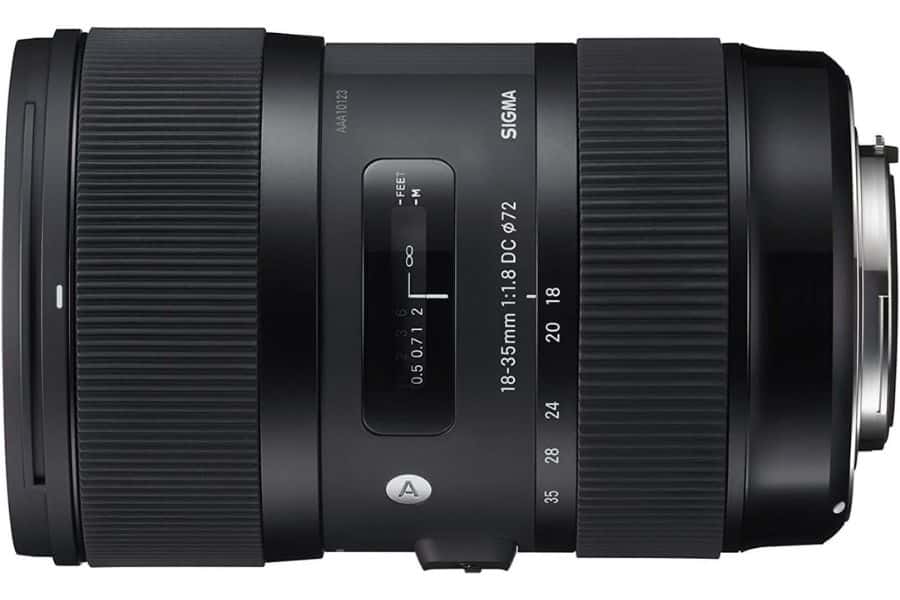
PROS:
+ Large aperture for a zoom
+ Affordable pro-grade gear
+ Excellent in night photography
CONS:
– A bit heavy
Despite having a premium price compared to other options, its superior specifications make it a worthwhile investment that delivers much more value than its cost suggests.
Build and handling: The Sigma ART series is highly regarded for its professional quality, making it a popular choice among photographers. Its sleek design, constructed with aluminum alloy, gives it a refined look and feel. Though it weighs 28.6 oz (810 g), it may be considered heavy, but not excessively.
Performance: The primary benefit of this lens is its exceptional f/1.8 aperture, a rare feature for zoom. Like other Sigma production, it also has a fast and silent focusing mechanism enabled by its hypersonic motor.
Best for: Its wide-angle capabilities and large aperture makes it well-suited for indoor photography, such as events, weddings, and product photography. It is also a great option for everyday photography, including travel, street, and portrait photography, delivering good results even in challenging conditions like low light and overexposed skies. Furthermore, it is considered the top choice for astrophotography on the Nikon D7000.
Its versatility and suitability for various shooting conditions make it a dependable choice. With this lens, you can confidently tackle any situation and expect outstanding results, even in challenging environments.
5. Sigma 17-50mm f/2.8 EX DC OS HSM
- Price: Budget $
- Dimensions: 3.29 x 3.61 in / 83.5 x 91.8 mm
- Weight: 19.9 oz / 565 g
- Filter size: Ø77
- Maximum aperture: f/2.8
- Focal length: 17-50 mm
- Image stabilization: Yes
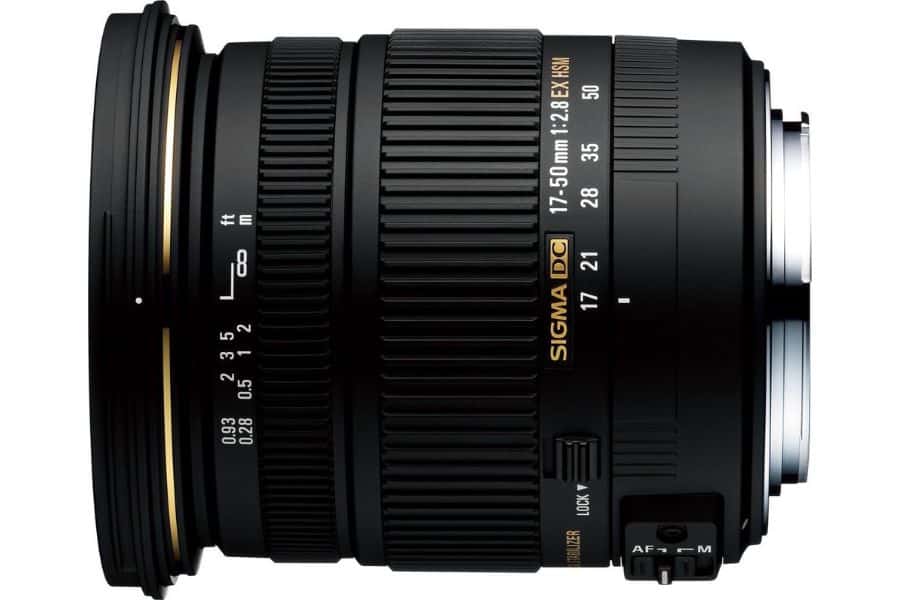
PROS:
+ A large aperture
+ Built-in image stabilization
+ Cheap for a zoom lens
CONS:
– A bit too heavy
Its wide aperture lets it focus on near and far subjects, making it a versatile choice. Its affordability and user-friendly design make it an ideal pick for those just starting in photography.
Build and handling: Though lighter than its predecessor, this lens still has a substantial weight that may become tiring during prolonged hand-held photography. However, it comes with built-in optical stabilization, which helps to mitigate the weight. The lens incorporates two Fluorite Low Dispersion elements, two glass-molded aspherical elements, and one hybrid aspherical element that work together to produce exceptional images. It also features Super Multi-Layer Coating, which reduces glare and enhances image quality.
Performance: This zoom lens may not have as large an aperture as the previous one, but its f/2.8 aperture is still noteworthy. The key advantage of this lens is its constant aperture, which provides consistently high-quality visuals in various shooting scenarios, especially in low-light photography. The images are sharp across most of the frame, with only a slight blur in the corners at mid-zoom settings.
Best for: This lens is ideal for travel photography, providing versatility for capturing various subjects. Its 17-50mm focal lengths can effortlessly be used for group shots, landscapes, street scenes, portraits, and more. This is a perfect choice if you’re searching for a lens that can handle all your travel photography needs.
Its f/2.8 aperture for a zoom lens and optical stabilization provide excellent performance and quality at an unbeatable value.
6. Sigma 17-70mm F2.8-4 Contemporary DC Macro OS HSM
- Price: Budget $
- Dimensions: 3.11 x 3.23 in / 79 x 82 mm
- Weight: 16.3 oz / 465 g
- Filter size: Ø72
- Maximum aperture: f/2.8
- Focal length: 17-70 mm
- Image stabilization: Yes
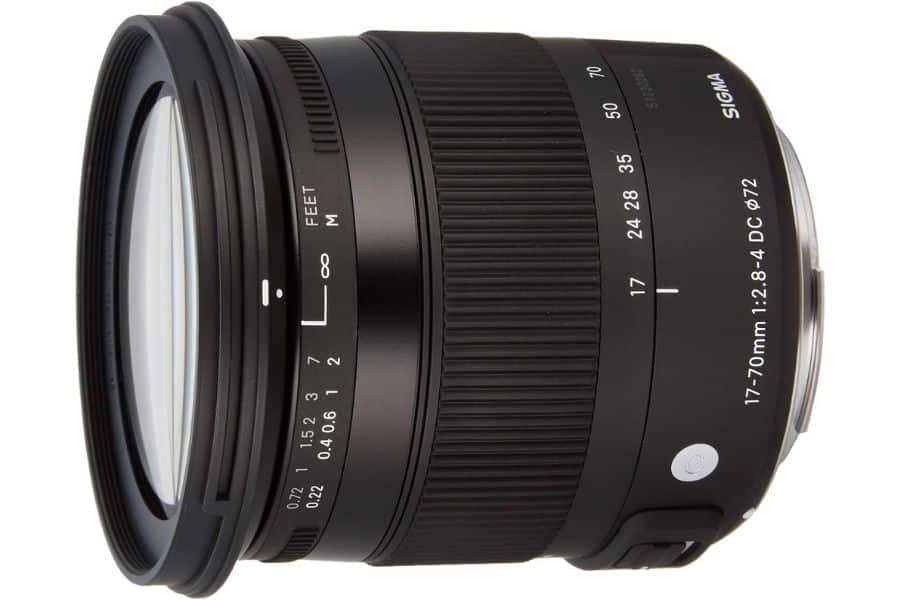
PROS:
+ Focal length from 17 to 70 mm
+ Image stabilization
+ Perfect for everyday use
CONS:
– A bit of distortion
The Sigma 17-70mm f/2.8-4 DC Macro OS Lens is a great all-around lens that offers a versatile focal length range, quick and precise HSM autofocus, effective optical stabilization, and a close minimum focus distance.
Build and handling: The lens combines plastic and metal parts, including a durable brass bayonet mount and high-quality glass optics. Additionally, Thermally Stable Composite material in its construction provides stability in changing temperature conditions. The lens also boasts a narrow manual focus ring directly behind the front element and a 7-blade rounded diaphragm that produces a pleasing bokeh effect.
Performance: The multipurpose lens can focus as closely as 8.6 inches, providing a 1:2.9 macro magnification at 70mm. This allows shallow depth-of-field shots, even at f/4 on a DSLR camera sensor. Additionally, the lens is equipped with built-in Vibration Reduction technology, which can be activated by the OS switch on the lens barrel, providing up to 3 stops of compensation.
Best for: Due to its focal lengths of 17-70mm, it can be versatile. At shorter focal lengths, it delivers great wide-angle shots even in low-light environments. You can capture photos of streets, architectural building details, and more when zooming out.
The Sigma 17-70mm F2.8-4 is an exceptional option that delivers superior image quality, versatility, and impressive macro performance at a surprisingly budget-friendly cost. It is also well-constructed, making it a great investment for photographers.
Wide-angle lens
7. Tokina AT-X PRO 11-16mm F2.8 DXII Lens
- Price: Average $$
- Dimensions: 3.5 x 3.3 in / 89 x 84 mm
- Weight: 19.4 oz / 550 g
- Filter size: Ø77
- Maximum aperture: f/2.8
- Focal length: 11-16 mm
- Image stabilization: No
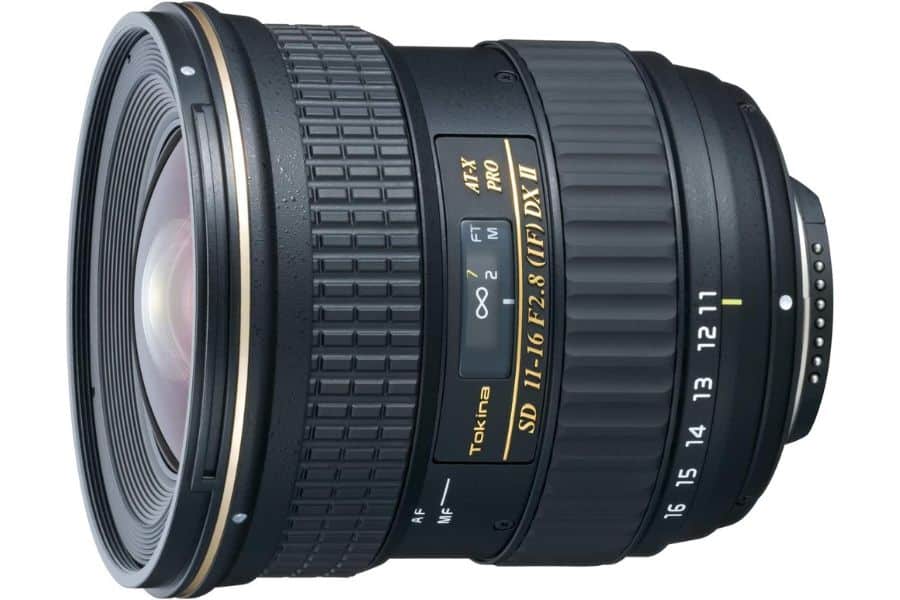
PROS:
+ Ultra wide-angle
+ Fast autofocusing
+ Impressive build quality
CONS:
– No image stabilization
This ultra wide-angle f/2.8 aperture lens ensures fast shutter speeds and active focusing even in low-light conditions. The consistent f/2.8 aperture throughout the zoom range makes it a great option for capturing clear and sharp images in various lighting situations.
Build and handling: The Tokina lens boasts a well-made plastic exterior with a rubber-coated ring for a solid grip. The lens features nine shutter blades in the aperture for a smooth, out-of-focus background. Two Super-Low Dispersion glass elements and two aspheric elements for exceptional contrast, sharpness, and minimal chromatic aberration. The improved multi-layer coatings minimize light reflection and enhance overall optical performance.
Performance: The autofocus system is quiet and precise, relying on an internal, silent motor. Most images are sharp, with only slight degradation near the edges. When shooting in bright daylight, there may be a slight amount of chromatic aberration (edges) or fringing, but it is easily corrected in post-processing.
Best for: Mostly used for real estate, indoor events, or somewhere where space is extremely tight. Also, the wide-angle view makes it ideal for landscapes or group photos, so a lot of activity can be fit into one frame. It is also one of the best Nikon D7000 lenses for night skies.
The Tokina 11-16mm F/2.8 lens boasts impressive build quality and a consistently fast aperture. Its performance at shorter focal lengths is exceptional.
Telephoto lenses
8. Sigma 150-600mm 5-6.3 Contemporary DG OS HSM
- Price: Expert $$$
- Dimensions: 10.2 x 4.1 in. / 260 x 105 mm
- Weight: 68.1 oz. / 1,930 g
- Filter size: Ø95
- Maximum aperture: f/5
- Focal length: 150-600mm
- Image stabilization: Yes
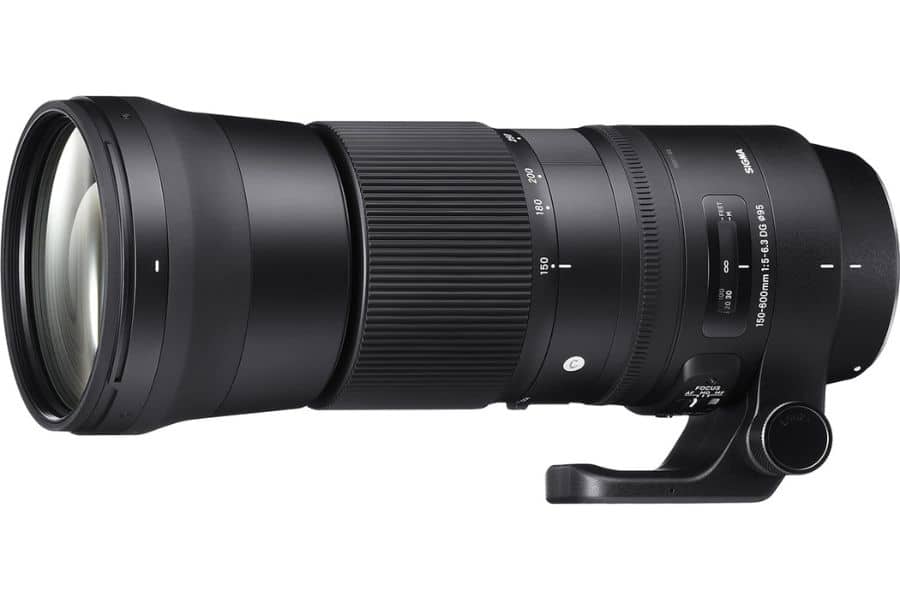
PROS:
+ Lightweight for superzoom telephoto
+ Built-in image stabilization
+ Affordable price
CONS:
– Above 500mm loses a bit of quality
It’s perfect for capturing wildlife or sports events and is a great value for a budget-friendly telephoto photography option.
Build and handling: Despite the typical weight of telephoto lenses being much heavier, this one weighs 68.1 oz (1,930 g), significantly lighter than many of its peers. Despite the reduced weight, it still has a professional feel and does not sacrifice performance capabilities.
Performance: This landscape lens is a standout choice, offering a broad range of focal lengths, a solid aperture, and several exceptional features. The high-speed hypersonic motor ensures smooth and accurate focusing, and the built-in image stabilization is another advantage of this lens, making it an excellent choice for landscape photography.
Best for: This telephoto lens is great for taking photos of faraway subjects, especially animals that are hard to get close to. Its 600mm maximum focal length is perfect for wildlife photography, and when used in combination with a tripod, it produces sharp and clear images. It’s not just limited to wildlife, though – it’s also ideal for sports photography and capturing intricate landscape details.
In conclusion, for those who aim to take photos of subjects from a distance, such as wildlife or sporting events, this lens is the top pick for your Nikon D7000. Although it may be pricier, it provides remarkable features and performance, making it a valuable investment.
9. Nikon AF-P DX NIKKOR 70-300mm f/4.5-6.3G ED
- Price: Budget $
- Dimensions: 2.83 x 4.9 in. / 72 x 125 mm
- Weight: 14.7 oz. / 415 g
- Filter size: Ø58
- Maximum aperture: f/4.5
- Focal length: 70-300mm
- Image stabilization: Yes
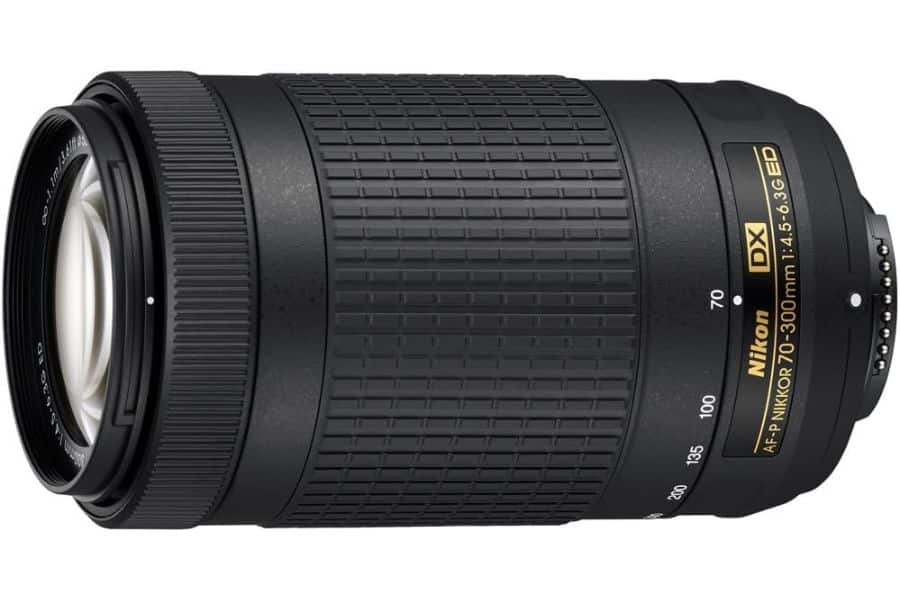
PROS:
+ Lightweight for a long-range zoom
+ Extremely affordable
+ Built-in image stabilization
CONS:
– Doesn’t perform well under the low light conditions
It’s a cost-effective option for those who want to save money when investing in a telephoto lens. Although it’s one of the most affordable lenses, it produces high-quality images and performs admirably.
Build and handling: This landscape lens has a construction that is standard for consumer-level Nikon lenses, not particularly outstanding but not lacking either. Its lightweight design of 14.7 oz. (415 g) makes it easy to use handheld and produce sharp images. Its simple and compact design makes it an excellent choice for capturing your subjects.
Performance: This lens has an f/4.5 aperture, which may not be ideal for low-light photography. To minimize the noise in images, a tripod may be required to slow down shutter speeds. However, it is equipped with VR (vibration reduction) image stabilization, making capturing subjects easier.
Best for: If you’re searching for a lens to shoot subjects from a distance, this one is an excellent choice. It performs exceptionally well when capturing wildlife and landscapes, and its lightweight design makes it easy to carry around, allowing you to quickly capture fleeting moments, such as rare birds, without the need to set up a tripod.
In summary, if you’re an amateur photographer seeking a cost-effective solution for wildlife photography with your Nikon DSLR camera, this lens is an excellent choice. It delivers outstanding value for its price and offers new perspectives to expand your photography collection.
Macro lens
10. Nikon AF-S VR Micro-NIKKOR 105mm f/2.8G IF-ED Lens
- Price: Average $$
- Dimensions: 3.3 x 4.6 in. / 83 x 116 mm
- Weight: 27.9 oz. / 790 g
- Filter size: Ø62
- Maximum aperture: f/2.8
- Focal length: 105mm
- Image stabilization: Yes

PROS:
+ Large aperture for low-light conditions
+ Focal length of 105mm
+ Built-in image stabilization
CONS:
– A bit heavy for hand-held shootings
This lens will be highly coveted by macro photographers due to its compact design that enables even DSLR sensor projections of life-sized images. The f/2.8 aperture and the optical stabilization system make it possible to capture fantastic images even in low-light situations.
Build and handling: This macro lens measures 4.6 x 3.3 inches (116 x 83 mm) in length and diameter and weighs 27.9 ounces (790 grams). It features a 62mm front filter thread and sturdy black composite construction. The manual focus ring has a comfortable, rubberized grip, and there are convenient toggle switches for setting the focus limit.
Performance: The lens features SWM technology for quick and quiet autofocusing and effortless switching between autofocus and manual modes. The IF system also allows for a non-rotating front lens element, making circular polarizing filters convenient. Its advanced VRII system allows for sharp images even at slower shutter speeds, up to four stops slower.
Best for: This macro lens is perfect for capturing small subjects or details, whether the flower seeds or the insects’ intricacies. With a focal length of 105mm, you won’t have to get too close to your subjects, so you will ensure that your photos are not obstructed by shade.
This Nikkor lens is a must-have for those passionate about macro photography. Its optical stabilization feature produces crisp images and allows close focus to achieve a 1:1 magnification.
Conclusion
With that, we’ve reached the end of our rundown of the best lenses for Nikon D7000. Although this camera has plenty of options, the lenses we’ve highlighted are considered the best for the Nikon D7000. It will also support professional-level lenses, which may not be necessary for this type of camera. We hope our guide will assist you in choosing your next lens!
Read more: Best Nikon DX lenses.
PIN IT
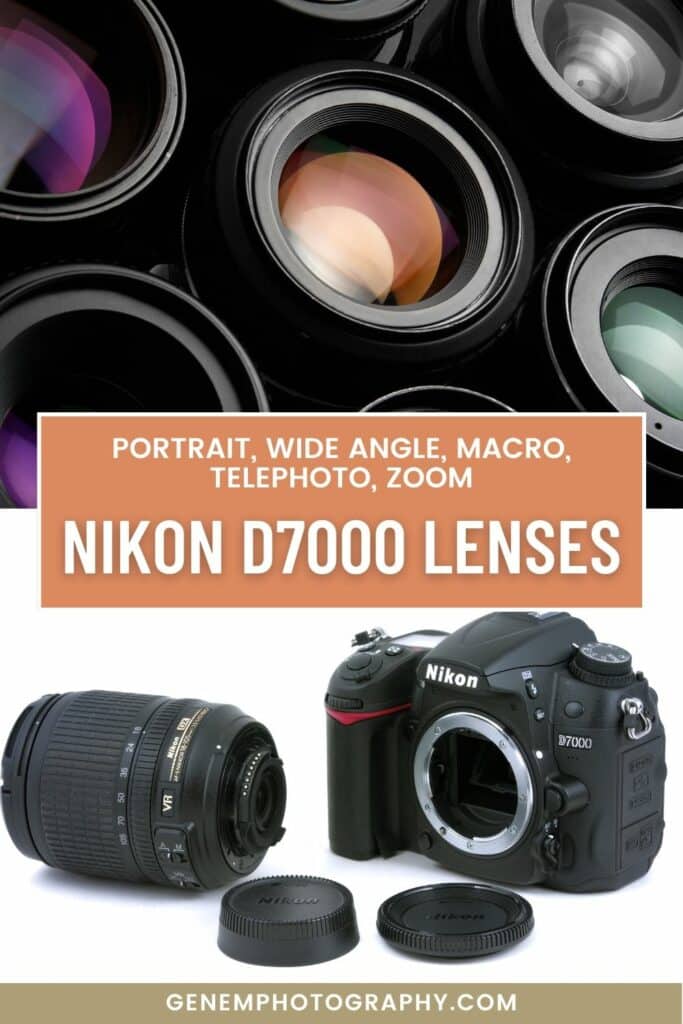
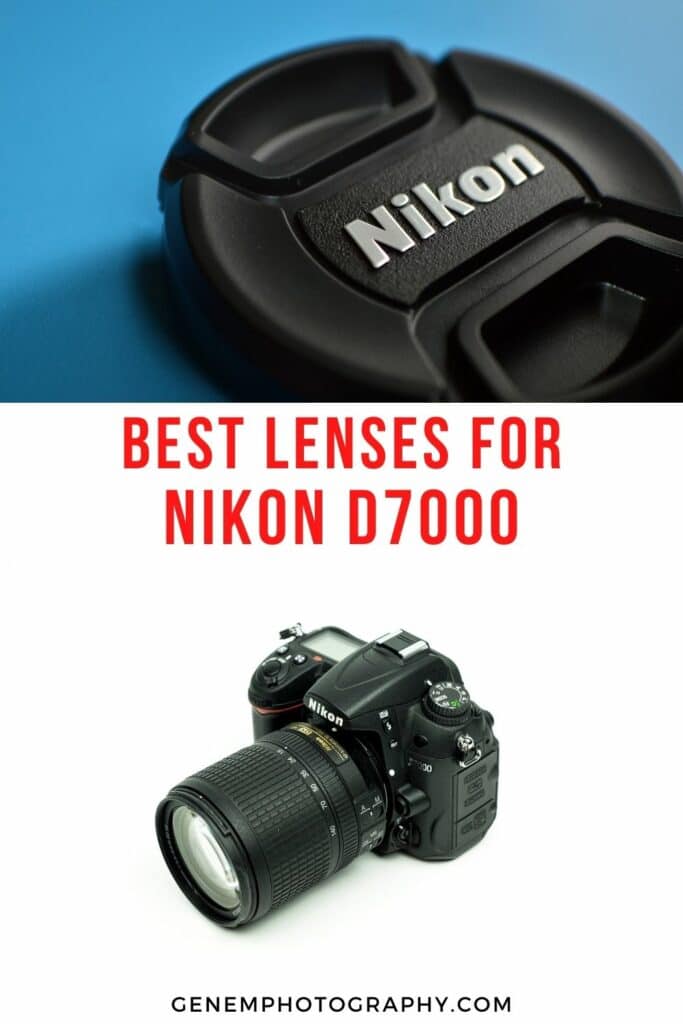
Read more about Nikon lenses:
